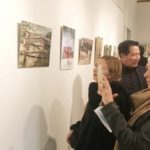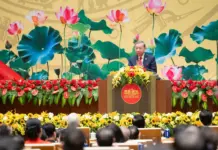Hang Trong folk paintings are a unique art form that is often seen adorning homes and shrines during Tet celebrations in Vietnam. These paintings not only serve as festive decorations, but they also provide a vivid glimpse into the landscape and cultural practices of the Vietnamese people. Their captivating beauty and rich symbolism make them an integral part of the country’s cultural heritage.
Visitors to the “Hang Trong Folk Paintings” exhibition, held by the People’s Committee of Hoan Kiem District, can reflect on the daily lives of farmers in the picturesque “Rest” or the social life of the past in the miniature painting “Western Festival”.
Modern art isn’t just for the modern age; it can also add a contemporary twist to classic art. From giving a classic painting a new life with a vibrant color palette, to re-imagining a centuries-old sculpture with a modern design, adding modernity to old art can create a unique and eye-catching piece of art. Whether it’s blending traditional techniques with modern materials or taking a traditional design and making it more modern, it can be a great way to bring a new perspective to old art. Plus, it can help to keep classic art alive in the modern world.
These stunning paintings by Hang Trong artisans have been expertly restored to their traditional standards by the highly skilled artisan Le Dinh Nghien. Now, they are proudly displayed in the collection of Nguyen Quang Trung.
The exhibition features an array of 23 works by up-and-coming artists, inspired by Hang Trong folk paintings. These pieces were crafted using a variety of materials discovered in painter Nguyen The Son’s workspace.
| A visitor at the exhibition of Hang Trong folk paintings. Photo: Ngo Minh |
The exhibition, entitled “From Tradition to Tradition”, is the result of renowned artist Nguyen The Son’s latest endeavour. Through this project, young artists explored the dialogue between traditional Vietnamese painting techniques such as lacquer and silk, and their modern interpretations. The goal was to promote and maintain the valuable heritage of these traditional painting styles.
A group of talented young artists who majored in Lacquer and Silk at the esteemed Faculty of Painting at Vietnam University of Fine Arts were fortunate enough to acquire the technique from renowned artisan Le Dinh Nghien thanks to their own initiative.
According to painter Nguyen The Son, “the exhibition is an opportunity to introduce the public to the unique collection of Hang Trong paintings crafted by artisan Le Dinh Nghien, as well as the new creations of young artists, who are always keen to explore traditional heritage values.”
In his opinion, incorporating traditional culture into artistic practice is a savvy way to safeguard and promote heritage values.
The renowned Hang Trong paintings, such as Ly Ngu Vong Nguyet (Carp Looks the Moon), Tam Da (Three Abundances), and That Dong (Seven Children), as well as the intricate details of the clouds and trees in the older Hang Trong artworks, acted as a source of inspiration for the talented painter Nguyen Cam Nhung and her collaborator’s folding screen.
In the artwork, the artists use a metaphor for a life of affluence, prosperity, richness, and abundance, as well as for ancestors’ past and valuable traditions. They have employed a subtle and concise technique to incorporate a contemporary twist into the representation of trees, symbolizing the conversation between the present and the past.
We want to introduce visitors to a variety of perspectives on art practice, as well as the connection between traditional and contemporary culture. Nhung is particularly inspired by the skill and passion of veteran craftsman Le Dinh Nghien for traditional art. By showcasing his work, we hope to create a bridge between the old and the new.
| Artisan Le Dinh Nghien talks to visitors at the exhibition. Photos: Ngo Minh |
Through the use of various traditional Vietnamese materials such as lacquer and silk, painter Nguyen Thi Nhu Quynh has created a stunning lacquer vase titled Red Tiger General. This work of art brings the traditional Hang Trong style of painting to life, showcasing the beauty and craftsmanship of Vietnamese culture.
After careful research and analysis, I have come to the conclusion that Hang Trong paintings and lacquer paintings share many similarities, from their color transitions to the level of detail that needs to be applied during the drawing process. In particular, lacquer is a great choice for creating the fine lines and contours of Hang Trong paintings. To give Hang Trong’s paintings vibrant and attractive colors, I decided to use lacquer to portray certain parts of the painting. This, I hope, will bring a unique and refreshing feeling to the viewers.
Renovated Heritage is a term used to describe buildings or sites that have been carefully restored to their original, or near-original, state. This process can involve restoring the architecture and interior design of the building to its original grandeur, as well as preserving any unique features or artifacts that are associated with it. It can also include repairs or upgrades to the building’s infrastructure, such as electrical, plumbing, and HVAC systems. Additionally, renovated heritage sites often feature improved energy efficiency, safety, and accessibility. The goal of any renovation project is to maintain the original character and charm of the building while ensuring that it is up to modern standards.
Talking to The Hanoi Times, artisan Le Dinh Nghien expressed his delight at the fact that the ancestral legacy of the younger generation is being preserved and propagated.
“This exhibition features only 23 ancient paintings, a small portion of the heritage of Hang Trong folk paintings – but it is of immense value, in my opinion, especially when Hang Trong paintings serve as both a material and emotional source of inspiration for young people to create, develop, and add their own artistic touches,” said Le Dinh Nghien.
| A lacquer vase embracing the image of Hang Trong painting. |
Assessing the effort of young artists in renovating Hang Trong paintings, PhD Tran Hau Yen expressed his astonishment at how seamlessly the exhibition combined the heritage element and the innovation factor. He was amazed by the skillful way in which the works of art managed to preserve the traditional values while still embracing modernity. The artworks encapsulated the essence of both the past and the present, creating a unique blend of tradition and modernity. The successful merging of these two elements was a testament to the hard work and dedication of the young artists involved in the project. It was an inspiring display of creativity and passion for the craft, and it was clear to see that the Hang Trong paintings had been given a new life.
By utilizing other traditional materials from Vietnamese art, such as silk and lacquer, young artists have increased the value of Hang Trong folk paintings. Traditionally, people painted on Poonah paper, but today’s young artists are experimenting with various mediums, such as folding screens, vases, recycled materials, and embroidery frames, to create their works,” said Tran Hau Yen The.
It is a type of painting on silk fabric, and is characterized by its bright and elegant colors, as well as its delicate brushstrokes and sophisticated compositions.
Hang Trong painting is one of three typical folk paintings of Vietnam, named after Hang Trong Street in the Hoan Kiem district of Hanoi, formerly known as Tho Xuong district in the Thang Long Capital. This type of painting is done on silk fabric and is renowned for its bright and elegant colors, as well as its delicate brushstrokes and sophisticated compositions. It has been an integral part of Vietnam’s cultural heritage for centuries and is still highly sought after today.
In Hang Trong folk paintings, woodblock prints are used exclusively to draw the bold and defining black contour lines that shape the artwork. Those bold lines are then enriched by hand-coloring, which gives the pieces a greater sense of dimension and vibrancy.
The genre of Hang Trong paintings may have found its last torchbearer in Master Le Dinh Nghien. As the sole purveyor of the craft, he is the only one who knows it from start to finish and is passing it on to his son, Le Hoan, and other young artists.
Using a unique approach, researcher Tran Hau Yen The believes that Hang Trong folk paintings can have a more varied life and be used in a wider range of settings, with greater applicability in interior decorating and architecture. This would open up exciting new possibilities for the traditional art form, allowing it to be more widely appreciated and celebrated.
The exhibition in Hanoi’s Old Quarter Cultural Exchange Center is running until April 16, located at 50 Dao Duy Tu Street in Hoan Kiem District. Don’t miss your chance to explore the incredible collection of artifacts and artworks!
A Glimpse of Hanoi’s Old Quarter
Recently, the Management Board of Hanoi’s Old Quarter cooperated with the city of Toulouse to open an exhibition named “Ke cho – Pho co” (City Dwellers – Old Quarter) at Hanoi’s Old Quarter Cultural Exchange Centre to depict the formation and development of Hanoi’s Old Quarter in the past 1000 years.











